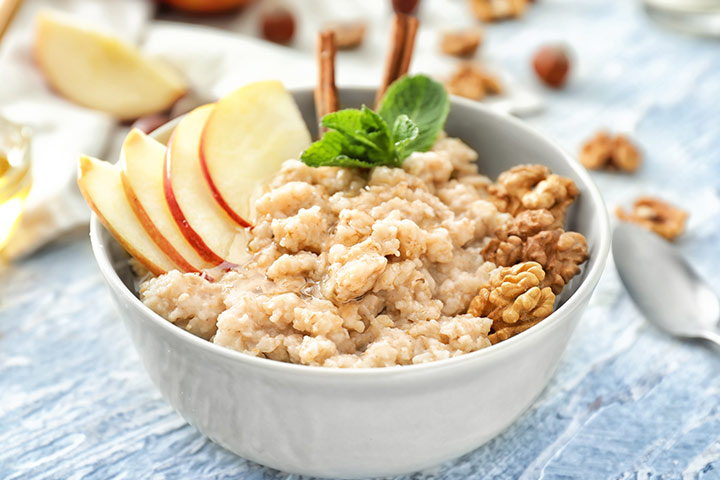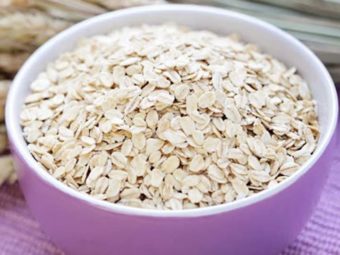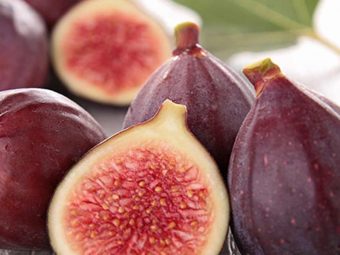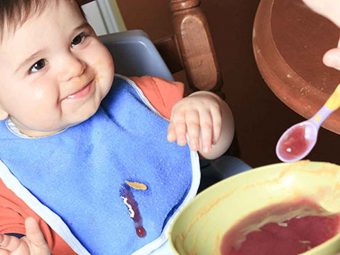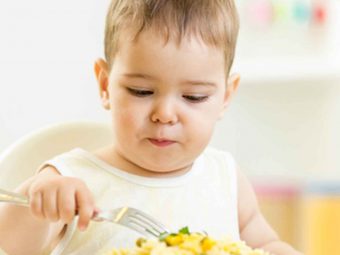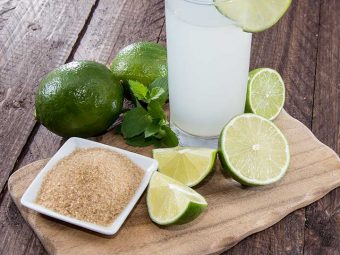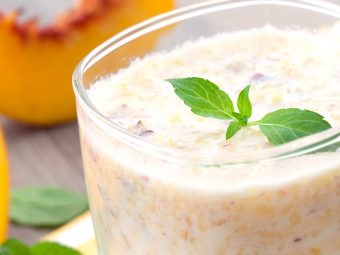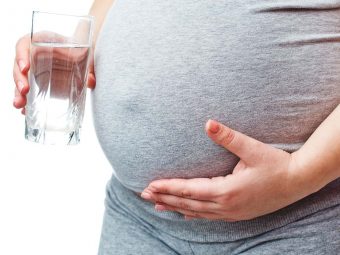
Image: ShutterStock
Consuming fiber-rich foods during pregnancy has several health benefits. For example, it helps you stay satisfied for longer without consuming extra calories, regulate blood sugar, relieve constipation, and lower the risk of cardiovascular diseases.
Pregnant women can easily meet their daily fiber requirements by eating a balanced dietconsisting of fruits, vegetables, cereals, and beans. If you cannot get enough fiber from your diet, consult a doctor for fiber supplements. However, even though fiber is good for you, consuming it in excess may lead to side effects such as abdominal pain or bloating.
Read this post for more information on the benefits of fiber during pregnancy, its side effects, some foods rich in fiber, and tips to increase your daily fiber intake.
What Are The Types Of Fiber And Their Role In Pregnancy?
The fiber found in plant-based diets plays a key role in digestive health. While it is not digestible and does not provide a direct energy source, it can still help improve prenatal health in various ways.There are two types of fiber – soluble andinsolubleiXA substance that cannot be dissolved, both of which are very important during pregnancy.
Jesse Feder, a registered dietitian from North Miami Beach, Florida, says,“Having fiber during pregnancy is healthy, as this allows proper gut health for the mom and proper nutrient absorption for both mother and child. Fiber intake during pregnancy also reduces the risk of developing gestational diabetes andpreeclampsiaiXA sharp increase in blood pressure. I have had pregnant clients come to me for nutrition consults who were severely lacking in fiber in their diets. After they increased their fiber intake, they felt more energetic, had healthier bowel movements, and decreased blood sugars.”
- Soluble fiber dissolves in water, forming a gel-like substance during digestion. It also manages cholesterol levels, reduces high sugar levels and lowers the risk ofheart problems.
- Insoluble fiber does not dissolve in water but makes its way through the digestive tract, and adds bulk to the stools (1).
What Are The Benefits Of Fiber During Pregnancy?
The benefits of fiber intake during pregnancy are as follows.
1. Controls pregnancy weight gain
A study based on data from Canadian Community Health Survey (CCHS)highlighted that 32% of Canadian women (n=1,335,615) experienced excessive weight gain during pregnancy.Fiber-rich foods keep you full for longer, preventing excess calorie intake and facilitating a healthyweight gainmanbet安卓版(2). Also, studies at the US National Institute of Health show that people on high-fiber diets tend to eat 10% fewer calories (3).
2. Prevents constipation
You can prevent constipation, which is a common digestive complaint during early pregnancy (4). The fiber adds bulk to your stools, easing bowel movements, and thereby providing constipation relief.
3. Regulates blood sugar levels
Getting enough fiber in your diet will slow down the food absorption, thereby preventing blood sugars levels from rising quickly (5).
4. Lowers the risk of cardiovascular diseases
Soluble fibers can lower bad cholesterol levels by binding to cholesterol-rich bile acids in the digestive tract. Fiber, therefore, reduces the risk of cardiovascular illnesses (6).
5. Reduces the risk of preeclampsia
The intake of dietary fiber will lower the risk of conditions such ashigh blood pressureand preeclampsia (7).
Studies have found that including vital dietary nutrients such as fiber, prebiotics, and probiotics might impart considerable health benefits.
How Much Fiber Do You require During Pregnancy?
The recommended daily fiber intake for pregnant women is 28g (8).
Following the correct fiber intake guidelines during pregnancy is ideal to support good maternal and fetal health.
15 High Fiber Foods For Pregnancy
Fruits, vegetables, beans, cereals and whole grains are excellent sources of fiber (8). Listed below are the fiber-rich foods you should include in your pregnancy diet to meet your daily requirement.
| High fiber foods | Standard amount | Dietary fiber (g) | Ways to include | |
|---|---|---|---|---|
| 1. | Almonds | 1oz | 3.3 |
|
| 2. | Bran cereal | ½ cup | 8 |
|
| 3. | Beans | ½ cup | 9.5 (navy beans) 8.2 (kidney beans) 6-7 (pinto, Lima, chickpeas, and lentils) |
|
| 4. | Broccoli | ½ cup | 2.8 |
|
| 5. | Collard greens | ½ cup | 2.7 |
|
| 6. | Rye crackers | One wafer | 2.5 (depends on the brand) |
|
| 7. | Prunes | One bite-size | 3 |
|
| 8. | Pumpkin | ½ cup | 3.6 |
|
| 9. | Pears | One small fruit | 4.3 |
|
| 10. | Blackberries | ½ cup | 3.8 |
|
| 11. | Sauerkraut (pickled cabbage) | ½ cup | 3 |
|
| 12. | Whole grain spaghetti | ½ cup | 3.1 |
|
| 13. | Baked potato | One medium-sized | 3.8 |
|
| 14. | Bananas | One medium-sized | 3.1 |
|
| 15. | Oranges | One medium fruit | 3.1 |
|
 Did you know?
Did you know?Is It Okay To Take Fiber Supplements While Pregnant?
It is okay and recommended to take fiber supplements during pregnancy for relief from constipation.PsylliumiXThe seeds of a plant used as a mild laxative、纤维素或Citrucel一些最好的纤维supplements you can consider, but with the advice of a doctor (9).
Are Fiber Gummies Safe During Pregnancy?
Fiber gummies act aslaxativesiXA chemical that encourages bowel movements, but there is no research supporting their use during pregnancy. It is better to talk to your doctor if you are planning to take them.
Are Fiber Choice Tablets Safe During Pregnancy?
Fiber Choice tablets are chewable tablets containinginuliniXAn oligosaccharide that occurs naturally and is indigestible and non-absorbable, a natural dietary fiber present infruits and vegetables. However, there is no research about their safety during pregnancy. You should speak to your doctor before planning to take them.
What Will Happen On Overeating Fiber In Pregnancy?
More often than not, you may fall short of the recommended dosage of fiber in your diet. But there are chances that you may take too much fiber, especially when you increase the fiber intake quickly. That can lead to (1):
- Constipation
- Abdominal pain
- Bloating andflatulenceiXRemoving gas from the digestive system through the back passage
- Temporary weight gain
- Diarrhea or loose stools
- Drop in blood sugar levels
- Blockages within the digestive tract
- Nutrients deficiencies if you are taking more than recommended amount for a prolonged period.
It is better to call your doctor if you have any of the above symptoms and also experiencenauseaiXUncomfortable stomach and a feeling of about to vomitand high fever.
 Quick tip
Quick tipTips To Increase Fiber Intake During Pregnancy
Feder suggests,“To increase your fiber intake during pregnancy, have a diet rich in a variety of fruits, vegetables, legumes, and whole grains. Some of the most common high-fiber foods include apples, berries, broccoli, beans, avocado, and spinach. Additionally, you can switch to snacks that are higher in fiber, such as popcorn.”
“Oatmeal is also one of the highest fiber foods you can consume. A serving of oatmeal can contain anywhere from four to eight grams of fiber, which is close to a third of a woman’s daily fiber requirements.”
Here are some quick tips for increasing the fiber intake in your diet (10).
- Drink more water when you have fiber-rich foods. Fiber acts as a laxative but is efficient only in the presence of sufficient water.
- Add fiber gradually, for your body needs time to adjust, Also, a quick increase in fiber will lead to gastrointestinal illnesses.
- Choose whole grain varieties of bread, cereals, pasta, and rice.
- Include extra vegetables in your curries, casseroles, and sauces, or take them as side dishes.
- Eat raw fruits and vegetables (as high-fiber snacks) between your meals.
- Munch a handful of nuts or cereals, or top them onsaladsand soups.
- Consult a registered dietitian for a personalized high-fiber diet.
 Quick fact
Quick factNext, we give you a few simple fiber-rich food recipes.
Fiber Rich Meal Ideas For Pregnant Women
1. High-fiber vegetable salad
You can enjoy this nutritious snack between meals. It is a mix of colorful vegetables, tossed with a zesty dressing to add an extraordinary flavor to it.
You will need:
- ¼ cup cabbage, shredded
- ¼ cup red cabbage, shredded
- ½ cup carrots, thinly sliced
- ½ cup cucumber, thinly sliced
- ¼ cup tomatoes, chopped
- ¼ cup green bell peppers, thinly sliced
- ¼ cup red bell peppers, thinly sliced
- ¼ cup yellow bell peppers, thinly sliced
- 2 tsp sunflower seeds, unsalted variety
For the dressing,
- 1 cup apple, grated along with skin
- 1tbsp lemon juice
- 1tbsp raisins, chopped (optional)
- 1/2tsp dried oregano
- 1tsp organic honey
- 1/8tsp salt
How to:
- Mix all the ingredients in a large bowl.
- Combine the dressing and mix well.
- Consume it fresh.
Preparation time:15min
Serving:4
2. Apple-cinnamon oats
A quick, fiber-packed meal that is ideal foryour breakfast.
You will need:
- 1 cup milk (preferably non-fat)
- 2/3rd cup rolled oats
- ¼ tsp cinnamon
- A few apple slices
- Handful of walnuts
How to:
- Add milk to the rolled oats.
- Sprinkle cinnamon and mix well.
- Cover the bowl and put it in the refrigerator overnight.
- Next morning, add the sliced apples and chopped walnuts and consume.
Preparation time:5min
Servings:1
Frequently Asked Questions
1. What’s a good breakfast when pregnant?
A good breakfast for a pregnant woman must contain healthy carbohydrates, protein, calcium, fiber, iron, and folate. While the other nutrients are necessary for the growth of the fetus, consuming a good amount of fiber in your breakfast could help relieve constipation.
2. When will constipation stop in pregnancy?
Constipation is more likely to be present throughout the pregnancy. You may experience it severely during the third trimester. This discomfort might stop three months after the birth of a baby (11).
3. Is fiber good for the uterus?
“Fiber is good for the uterus because it helps remove toxins from the body as it absorbs many things along the digestive tract. This helps keep a good balance of healthy bacteria in our bodies. Fiber can also remove excessestrogeniXA steroid hormone vital for female reproductionthat may form, which can preventfibroidsiXNon-cancerous tumors that develop in or around the uterusfrom developing in the uterus,”opines Feder.
A fiber-rich diet has plenty of health benefits. It helps in maintaining bowel health, aids in blood sugar control, and reduces the chances of cardiovascular health and preeclampsia. By making small changes in your diet, you can ensure ample fiber intake during pregnancy. Your gynecologist or nutritionist may also prescribe some fiber supplements to help you meet your daily recommended fiber intake. Avoid using any OTC fiber supplements without your doctor’s consent. Also, avoid overconsumption of fiber as it may cause some gastrointestinal problems during pregnancy.
Infographic: Points To Consider When Increasing Pregnancy Fiber Intake
During pregnancy, including more fiber in your diet is not only essential for good digestive health but also satiates your hunger for a longer period. However, avoid overconsumption as it can affect adversely. Look at the infographic below to take note of a few things you must follow when increasing your fiber intake during pregnancy.

Illustration: Momjunction Design Team
Get high-quality PDF version by clicking below.
Download Infographic
Key Pointers
- Consuming fiber reduces the risk of cardiovascular disease, gestational diabetes, and preeclampsia while preventing weight gain, regulating blood sugar levels, and preventing constipation.
- For pregnant women, a daily fiber intake of 28g is advised.
- If necessary, fiber supplements are acceptable, but only after seeing a physician.
- Abdominal pain or bloating may occur as a result of excessive fiber consumption.
- Almonds, bran cereal, beans, broccoli, carrots, chia seeds, flaxseeds, apples, avocados, and berries are a few foods high in fiber that you can eat when pregnant.
References:
- Nutrition and Health Info Sheet: Fiber.
https://nutrition.ucdavis.edu/sites/g/files/dgvnsk426/files/content/infosheets/factsheets/fact-pro-fiber.pdf - Fiber.
https://lpi.oregonstate.edu/mic/other-nutrients/fiber - Rough Up Your Diet.
http://citeseerx.ist.psu.edu/viewdoc/download?doi=10.1.1.174.172&rep=rep1&type=pdf - Common Discomforts During Pregnancy.
https://www.chop.edu/conditions-diseases/common-discomforts-during-pregnancy - Gestational diabetes.
https://www.northwell.edu/sites/northwell.edu/files/2017-11/Gestational-Diabetes-Brochure_single-page__0.pdf - Fiber: the Basics.
https://www.med.umich.edu/pfans/_pdf/hetm-2016/0816-roleoffiber.pdf - Chunfang Qiu et al.; (2008); Dietary fiber intake in early pregnancy and risk of subsequent preeclampsia.
https://pubmed.ncbi.nlm.nih.gov/18636070/ - Rachelle A. Pretorius and Debra J. Palmer; (2021); High-Fiber Diet during Pregnancy Characterized by More Fruit and Vegetable Consumption.
https://www.ncbi.nlm.nih.gov/pmc/articles/PMC7824257/ - Improving Your Health With Fiber.
https://my.clevelandclinic.org/health/articles/14400-improving-your-health-with-fiber - High Fiber Diet.
https://www.rush.edu/sites/default/files/2020-09/high-fiber-diet.pdf - Pregnancy Constipation.
https://my.clevelandclinic.org/health/diseases/21895-pregnancy-constipation#:~:text=You’re%20most%20likely%20to - Kassem Makki et al.; (2018); The Impact of Dietary Fiber on Gut Microbiota in Host Health and Disease.
https://pubmed.ncbi.nlm.nih.gov/29902436/ - How much fiber is in whole grains versus refined grains/non whole grains?
https://ask.usda.gov/s/article/How-much-fiber-is-in-whole-grains-versus-refined-grains-non-whole-grains#:~:text=While%20fiber%20content%20differs%20among,to%203%20grams%20of%20fiber




 Research finds
Research finds


